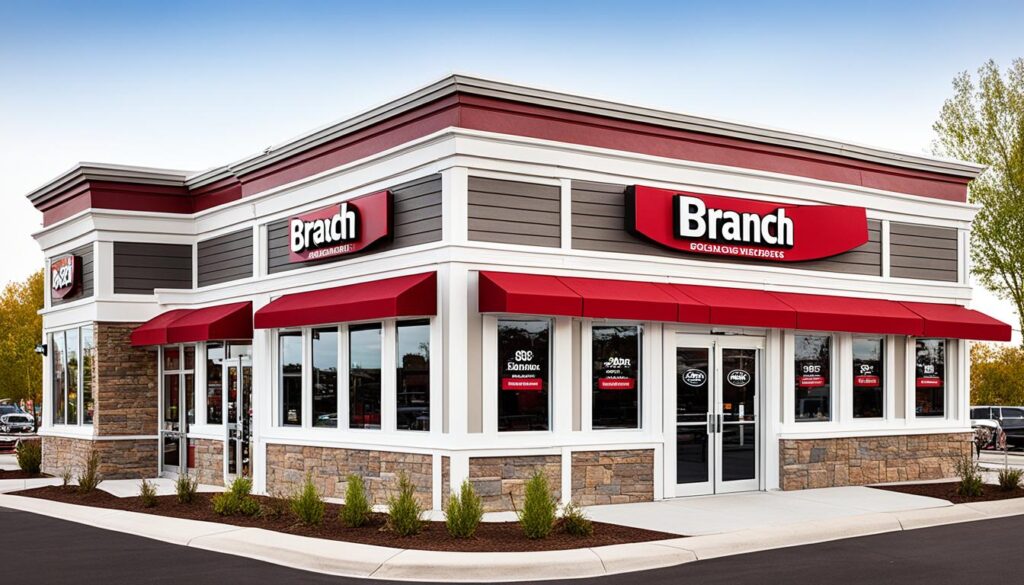Thinking about starting a business or growing an existing one? It’s important to know the difference between a branch and a franchise. This knowledge will help you pick the best path forward. 
Branches and franchises have unique ways to grow and make money. They differ in who owns them, their models, and how they expand. Exploring these differences will help you understand your options better.
Key Takeaways:
- Branches and franchises differ in terms of ownership structure, with branches being company-owned and franchises involving a legal relationship between a franchisor and a franchisee.
- Branches give the parent company full control over what happens, but franchises let the franchisee run things more independently within the rules set by the franchisor.
- How profits are shared is another big difference. In branches, all the money goes back to the main company. In franchises, there’s a shared revenue model between the franchise owner and the company.
- It takes direct money from the parent company to set up a branch. Franchises, on the other hand, let you grow quickly in new markets without as much risk or cost.
- Both branches and franchises focus on keeping the brand strong and the quality high. But, branches and franchises handle control and rules differently to keep the brand consistent.
Defining the Concepts of Branch and Franchise
Understanding the differences between branches and franchises requires clear definitions. We’ll look into what makes a branch and a franchise unique. This includes their business models and legal situations.
What Is a Branch?
A branch is a business fully owned and managed by a parent company. It bears the same name and brand as the parent company. The parent company controls the branch entirely, making its decisions and taking responsibility for it.
What Is a Franchise?
A franchise includes a legal agreement between a franchisor and a franchisee. The franchisor, who owns the brand and business plan, partners with a franchisee. The franchisee, an individual or business, buys the right to operate under the brand. They run as an independent business following the brand’s rules and standards.
Franchises give people the chance to run their businesses with an established brand’s backing. It benefits both the franchisor and the franchisee.
Ownership Structure and Business Models
In a branch setup, the parent company has complete ownership and control. This model ensures the branch operates in line with the parent company’s vision. It functions as part of the parent company, representing its goals and adopting its methods.
Franchises involve shared ownership between the company and the franchisee. The brand owner keeps the brand control, while the franchisee runs a specific location. This model supports brand growth through various locations.
Franchising lets individuals be their own bosses with the franchisor’s support. They get to use a successful brand, easing up on startup challenges.
Legal Relationship
The relationship between a branch and its parent is clear-cut. They are part of the same ownership. The parent company calls the shots, managing everything and taking legal responsibility.
Franchising involves legal commitments from both sides. The franchisor lets the franchisee use the brand in exchange for fees and following certain rules. This agreement helps in keeping a unified customer experience.
| Branch | Franchise |
|---|---|
| Owned and operated by parent company | Operated by franchisee under the brand’s name |
| Full ownership and control by parent company | Shared ownership between franchisor and franchisee |
| Operates under parent company’s business model and brand | Operates under shared guidelines and standards set by franchisor |
Ownership Structure and Control
This part looks at how branches and franchises are owned and run. Knowing who calls the shots is key to smart business choices. We will look at who holds the power in branch and franchise setups.
Authority in a Branch Model
In a branch setup, things are clearer. The main company has total say over everything, from what’s on the menu to how things are done. They steer the ship, making sure their name and rules are followed at every branch.
Independence in a Franchise System
Franchises offer a bit more freedom. Yes, there are rules to follow, but franchise owners get to run things their own way. It’s like having your business with a big brand’s support.
Franchise works this way. You can buy in and run it like it’s yours. You get to pick your team and tweak some things for your area’s needs. This mix of making your calls and brand back-up can make your franchise a hit.

It’s important for anyone wanting to set up shop to get how this works. Whether you lean towards the full-on guidance of a branch setup or the freedom of a franchise, knowing the ups and downs is crucial for success.
Branch vs Franchise: Analyzing Operational Command
When we compare branches and franchises, it’s key to look at how they run things day-to-day. This includes the decisions they make, who controls the operations, how they ensure quality, and the effect this has on how customers see the brand. Knowing about these differences is vital. It helps people who are starting or running a business to choose the right way to manage things.
In branch models, the main company holds all the strings. The parent company decides everything and is in charge of the day-to-day stuff. This means a very high level of quality and that the brand always looks the same. The parent company makes sure its rules are followed exactly.
On the other hand, franchises are a team effort between the owner of the brand and the local business owner. The brand owner gives guidelines, but the local owner can make some choices too to fit the local area. This gives the local business owner some power over their operation. Yet, how much they can change things depends on their agreement. Still, the brand owner makes sure that quality and the brand rules are followed by checking up on them rgularly.
In looking at how things are run, we must think about what we prioritize. Branches offer strong control and always keep the brand looking the same. In contrast, franchises give a bit of freedom to the local owner to adjust to local tastes. There are good and not-so-good sides to each approach. Which is best depends on what the business aims for and how it plans to grow.
For a clearer understanding, check the table below. It shows how branches and franchises differ in how they manage things:
| Branches | Franchises | |
|---|---|---|
| Decision-Making | Centrally controlled by the parent company | Shared responsibility between franchisor and franchisee |
| Operational Control | Parent company has full control | Franchisee has some autonomy |
| Quality Assurance | Strictly enforced by the parent company | Enforced through brand guidelines by the franchisor |
| Brand Consistency | Maintained through centralized oversight | Upheld through brand guidelines |
Fiscal Considerations and Profit Distribution
When looking to branch out or franchise, it’s key to know about the finances and how profits are handled. Choosing between a branch or a franchise affects how you earn and share profits. This choice can really change your business’s success in the long run.
Earning Dynamics in a Branch
All profits in a branch model go to the main company. This means the parent company gets all the money the branch makes. It also takes on the financial risks but has full control over what the branch brings in.
Revenue Sharing in a Franchise
In a franchise model, profit sharing is different. The franchisor and franchisee agree on how to split up the money. The franchisee gets to use the brand and business model but shares profits with the franchisor. How much profit the franchisee gives the franchisor depends on their agreement.
Branches and franchises have very different money setups. While branches boost the parent company’s finances, franchises can make money for both the owner and the franchisee. This sharing in franchising lets new business owners join a known brand while splitting both the risks and rewards.
Knowing the details about money and profit in branches and franchises is vital. Deciding if you want full control or to share profits with a franchisor is a big choice. It’s important to look closely at the financial effects of each model to see what matches your business dreams best.
Investment Implications and Expansion Strategies
When looking to grow a business, it’s key to think about the investment side and how to expand. There are unique chances and factors to check before you choose between starting branches or offering franchises. These are important for both business owners and people putting money into the company.
Opening a branch means the main company puts money directly into it. This gives the company full control. The parent company keeps the power over decisions and keeping the brand consistent. It’s good for businesses wanting a strong presence in one area, using what they know well. This method is strong for keeping a consistent customer experience.
Branch investment offers a high level of control and brand consistency, making it a suitable strategy for businesses focusing on maintaining a unified customer experience.
Franchising lets businesses grow quickly in new areas with less of their own money and risks. In a franchise, someone else (the franchisee) uses your brand under specific rules. These independent owners put up money to open and run their stores. This helps spread the brand further without the company spending all the money itself.
When you choose franchising, you tap into the franchisee’s knowledge and connections in that area. They work hard to grow their store while keeping your brand strong. It lets companies enter new markets fast, with less money upfront. This way, businesses don’t have to invest as much at the start.
| Investment Implications and Expansion Strategies | Branch Investment | Franchise Investment |
|---|---|---|
| Investment Structure | Parent company provides full investment | Franchisees contribute investment capital |
| Control | Parent company maintains operational control | Franchisees operate under brand guidelines |
| Market Penetration | Establishing a strong presence in specific locations | Rapid expansion in new markets |
| Growth Potential | Utilizes existing resources and expertise | Leverages franchisees’ local knowledge and efforts |
Both starting branches and franchising have their pros and cons. Business owners need to think about their money, goals, and what the market is like. Then, they can choose the best way forward. Making smart choices leads to growing the business well and keeping it strong over time.
Brand Consistency and Quality Assurance
Keeping a brand’s look and making sure things are top quality are key for success, whether it’s a branch or a franchise. They help build a strong brand image and keep customers trust.
Maintaining Standards in Branches
A branch works under the parent company’s direct control. This means each location matches the others in how they look and work. The parent company makes sure the brand stays strong by watching closely and setting clear rules.
Branches have to stick to the rules and look of the parent company. They use the same logos, ways of helping customers, and how they do things. This makes sure the brand always tells the same story, no matter which branch you visit.

Upholding Quality in Franchises
Franchises keep the brand strong by following the franchisor’s rules. Even though they can make some choices on their own, they need to follow these rules. This is how the brand’s quality and reputation stay high.
The franchisor gives detailed rules on how things should be done. This includes how the brand is shown, what customers can expect, how good the products or services need to be, and even how staff should be trained. All franchises have to follow these rules to make sure each one is the same.
The franchisor also helps franchisees keep up with the brand’s standards. They offer training and check on them regularly. This is to help them get better and always meet the brand’s rules.
Sample Table:
| Branch Model | Franchise System |
|---|---|
| Brand consistency maintained through centralized control | Brand consistency maintained through franchisor-established guidelines |
| Strict standards and guidelines set by the parent company | Comprehensive guidelines provided by the franchisor |
| Direct monitoring and enforcement of brand standards | Ongoing support, training, and evaluations to ensure compliance |
Comparing Growth Approaches: Branch Expansion Versus Franchise Development
When you look at growing your business, you have two main options: branch expansion and franchise development. Both aim to increase market coverage and growth. However, they have different benefits and paths. Knowing these details will help you choose the right way forward for your business.
The Scale of Growth in Branch Expansion
Branch expansion means opening new company branches in various places. This allows for total control over the branches. Companies can ensure their operations and brand look the same everywhere.
Companies can enter new markets quickly with this direct way. They use their established brand to do so. This method allows for steady and controlled growth, especially for companies with specific products or services.
Yet, starting branches can be costly. Companies need to spend on hiring, training, and more for each branch. Also, growing through branches depends on the parent company’s financial strength.
Franchise Growth Trajectory
Franchising is another method for growth. Here, individual franchisees run their own outlets under the brand. This leads to fast coverage thanks to the work of many franchisees.
This way, businesses can have their brand in many places sooner. And they don’t carry the full financial load of branch opening. Franchisees bring their skills and knowledge of their local areas too.
However, keeping the brand and quality the same everywhere is a challenge. Businesses must work hard to train, guide, and check on franchisees to maintain standards.
In conclusion, branch expansion and franchising have their own benefits and issues. Branch expansion gives direct control and steady growth. On the other hand, franchising brings quick brand spreading. To pick the best approach, businesses need to consider their objectives, resources, and risks carefully.
Employee Management: Branches vs Franchises
How employees are managed can differ in branches and franchises. Knowing these differences can aid entrepreneurs in picking the best model for them.
Branches have the parent company handling employee recruitment and management. They are in charge of hiring, training, and keeping a check on branch workers. This ensures that rules and practices are the same in each branch.
Contrastingly, in a franchise, the franchisee manages employees. They can pick, train, and handle their team as they see fit within the franchisor’s rules. This way, each franchise can adjust to local needs, making it more flexible.
Branches follow set management methods, while franchises allow for more local touch in finding and growing the talent. Both approaches have their strong points when it comes to finding, training, and keeping good workers.
The type of employment rules can also change between branches and franchises. For branches, the parent company creates these rules. This keeps things like benefits, pay, and HR the same across all branches. On the other hand, franchisees mix national standards with what the local laws and markets need.
When deciding on a branch or a franchise, it’s crucial to think about your employee needs. Look at what you want in HR, how much control you need, and your market’s requirements. Such evaluations will lead to a smarter choice.

Autonomy in Business Decision-Making
Running a business successfully means making decisions without needing constant approval. In a franchise, this is even more crucial. Franchisees can make choices that fit their local area, following the franchisor’s rules.
This freedom sets franchising apart from other business types. It lets local business owners meet their area’s needs better. They can choose products and marketing that locals will like.
Franchisors give rules to keep the brand same everywhere. But, they also let franchisees have some say in what they do. This keeps the brand’s spirit while adapting to local ways.
Franchising balances control and freedom well. It gives the support and systems of a big company. But, it also lets business owners change things to fit their own area.
This freedom helps not just each store to do well but also grows the whole franchise. Business owners who feel they can make real decisions work harder. They help the brand do better.
Thanks to this balance, franchise owners can be creative. They can run a business with their ideas. At the same time, they benefit from the franchise’s support and ways of doing things. This balance helps the whole franchise to grow for the long term.
Pros and Cons of Branches Versus Franchises
Entrepreneurs often debate on starting a branch or a franchise. They look at each option’s pros and cons for their business. Both have advantages and drawbacks to consider.
Advantages of Running a Branch
Starting a branch under an existing brand gives you control. You make the business fit your vision while keeping the brand’s identity. This means you can decide how to run things.
Also, you get to work closely with the main company. You might use their systems and get support, making running your branch more manageable.
By using a big brand, you rely on its reputation to grow. This makes growing your business easier and safer than starting your own brand from scratch.
Benefits of Franchising for Growth
Franchising is good for fast growth. You get to use a known brand and model. This makes it easier to start without having to build everything on your own.
Franchising also cuts down on the risk. You learn from the franchisor’s success and mistakes. Their experience helps you avoid common startup issues.
With franchises, the brand can grow quickly in many places. The cost and effort for expanding aren’t all on you. This is a major advantage for growing your business at a lower risk.
Both branches and franchises have their benefits. Branches offer control and building over a strong brand’s image. Franchises let you grow quickly with less risk. The choice between the two depends on your goals and how much freedom you want to run your business.
| Advantages of Running a Branch | Benefits of Franchising for Growth |
|---|---|
| Full control over operations and decision-making | Reduced financial risk and investment |
| Opportunity to establish a strong partnership with the parent company | Access to a proven and successful business model |
| Potential for growth within an existing brand | Rapid market penetration and expansion through multiple franchise units |

Conclusion
It’s key for those dreaming of business to know the difference between branches and franchises. This choice can greatly change a business’s success and how it grows. Thinking carefully about these two options helps make decisions that match personal goals.
Branches offer full control and let entrepreneurs keep a consistent brand. They are perfect for those who want to be in charge. On the flip side, franchises help reach markets quickly with less risk. For fast expansion and new market entry, franchising is a smart move.
Both branches and franchises have pros and cons. Choosing between them depends on things like how much money you have, how you plan to grow, and your need for control. It’s vital to think through these aspects and pick what suits your goals and passion best.
